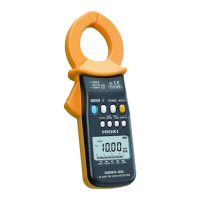8
Operating Precautions
Handling of the instrument
DANGER
• Do not input a voltage or current in excess of the
ratings indicated on instrument labeling or the
measurement range listed in the specifications.
Doing so may cause damage to, or heating of, the
instrument, leading to bodily injury.
• The maximum measurement current varies with the
frequency, and the current that can be measured
continuously is limited. Operating the instrument at
less than this limitation is referred to as derating.
Do not measure currents in excess of the derating
curve. Doing so may result in instrument damage or
malfunction, re, or burns due to sensor heating.
• To avoid short circuits and potentially life-
threatening hazards, never attach the clamp to a
circuit that operates at more than 300 V AC rms.
• Be sure to connect the instrument to the secondary
side of circuit breakers. In the event of a short, this
side of the circuit breaker will be protected from any
short-circuit current by the breaker. The primary
side of circuit breakers is characterized by high
current capacity, and any short-circuit could result
in damage to the instrument or other equipment.
WARNING
To avoid electric shock, do not approach high-voltage
equipment or wiring when taking measurements
using a transformer's ground wire. If measurement
is difficult because the ground wire is located close
to an exposed high-voltage conductor, reroute the
ground wire before measurement.

